Abstract
The mandibular position is determined by several physiological factors, which should be considered for diagnosis, therapy and stability. Sixty-eight lateral skull radiographs were taken and plotted to determine the relationship of the occlusal plane with the mandibular position among others. A Spearman statistical analysis was performed to determine the relationship between these variables. The occlusal plane showed a statistically significant correlation with mandibular position.
1. Introduction.
The position, size, and shape of the mandible are determined by different factors, such as the cranial base’s flection, the vertical dimension, and the incline of the occlusal plane. This last factor is related to function, so, if there is no functional lateral movement of the mandible during mastication, a malocclusion may develop [1].
2. General objective
To determine whether there is a relation between the posterior occlusal plane, the inclination of the clivus, the anterior cranial length, the articular angle, and the angle of the sella with regards to the mandibular position.
3. Methodology
A finite (68) sample of lateral skull radiographs of patients with an average age of 19.5 years was used to determine the relation of the variables in Fig. 1 to mandibular position. Pearson’s correlation statistical test was used for continuous variables, and Spearman’s test for nominal variables, using a SPSS V. 26.0 program, as seen in Table 1.
Table 1Correlation of the variables: posterior occlusal plane – horizontal frankfurt plane (POP-HFP), and mandibular position (SNB)
POP – HFP | |||
X-rays (68) | SNB | Pearson’s correlation | –0.625* |
Sig. (bilateral) | 0.046 | ||
*The correlation is significant at the 0.05 level | |||
Fig. 1Sample of lateral skull radiographs
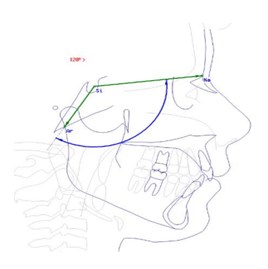
a) Variable angle of the sella
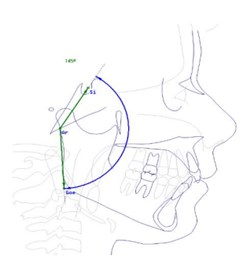
b) Variable articular angle
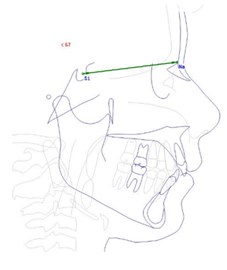
c) Variable anterior cranial length
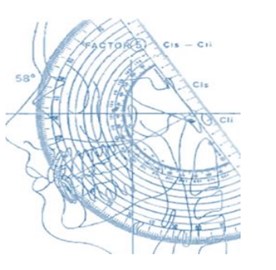
d) Variable inclination of the clivus
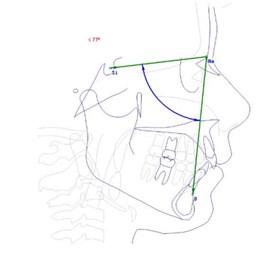
e) Variable mandibular position
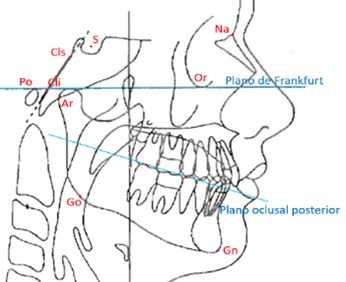
f) Cephalometric points and plans
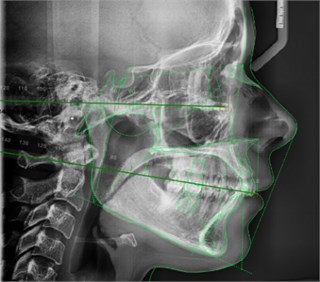
g) Cephalometric tracing in the NemoStudio v.19.2.0 program
4. Results
From Bimler’s analysis, 27 of the -rays analyzed belonged to patients with distoclusion, 23 to patients with mesioclusion, and 18 to patients with normal occlusion. An inversely proportional relation was observed between the posterior occlusal plane, and the position of the mandible. The articular angle, the angle of the sella, the anterior cranial length, and the inclination of the clivus didn’t appear to be corelated to the mandibular position.
Table 2Correlation of the variables: Articular angle (A), Angle of the sella (S), anterior cranial longitude (ACL), and inclination of the clivus (INCL. CLIV.) with regards to the mandibular position (SNB)
X-rays (68) | SNB | A | S | LCA | INCL. CLIV. | |
Spearman’s Rho | –0.192 | 0.110 | 0.230 | –0.243 | ||
Sig. (bilateral) | 0.247 | 0.511 | 0.165 | 0.142 |
5. Discussion
Previous studies stablished a relation between the posterior occlusal plane and the mandibular position [2-4], which coincides with the findings of the present study. Coro proved that there is significant correlation between the mandibular position in the three spatial coordinates, and mandibular morphology [5].
6. Conclusions
There is a significant relation between the posterior occlusal plane and the mandibular position. This relation was not observed in any of the other studied measurements. As the occlusal plane is a fundamental factor when it comes to oral rehabilitation, knowing its relation to mandibular position allows us to make timely diagnostics and thus prevent malocclusions and future articular problems.
References
-
S. Sato, H. Sakai, and T. Sugishita, “Developmental alteration of the form of dentadure frame in skeletal Class III malocclusion and it’s significance in orthodontic diagnosis and treatment,” International journal of the MEAW Technic and Research Foundation, pp. 74–87, 1994.
-
E. M. Tanaka and S. Sato, “Longitudinal alteration of the occlusal plane and development of different dentoskeletal frames during growth,” American Journal of Orthodontics and Dentofacial Orthopedics, Vol. 134, No. 5, pp. 602.e1–602.e11, Nov. 2008, https://doi.org/10.1016/j.ajodo.2008.02.017
-
K. Fushima, Y. Kitamura, H. Mita, S. Sato, Y. Suzuki, and Y. H. Kim, “Significance of the cant of the posterior oclusal plane in Class II división I malocclusions,” European Journal of Orthodontics, Vol. 18, No. 1, pp. 27–40, 1996.
-
A. Čelar, E. Tafaj, A. Graf, and S. Lettner, “Association of anterior and posterior occlusal planes with different Angle and skeletal classes in permanent dentitions,” Journal of Orofacial Orthopedics/Fortschritte der Kieferorthopädie, Vol. 79, No. 4, pp. 267–276, Jul. 2018, https://doi.org/10.1007/s00056-018-0139-z
-
J. C. Coro, R. L. Velasquez, I. M. Coro, T. T. Wheeler, S. P. Mcgorray, and S. Sato, “Relationship of maxillary 3-dimensional posterior occlusal plane to mandibular spatial position and morphology,” American Journal of Orthodontics and Dentofacial Orthopedics, Vol. 150, No. 1, pp. 140–152, Jul. 2016, https://doi.org/10.1016/j.ajodo.2015.12.020
About this article
The authors have not disclosed any funding.
The datasets generated during and/or analyzed during the current study are available from the corresponding author on reasonable request.
The authors declare that they have no conflict of interest.
